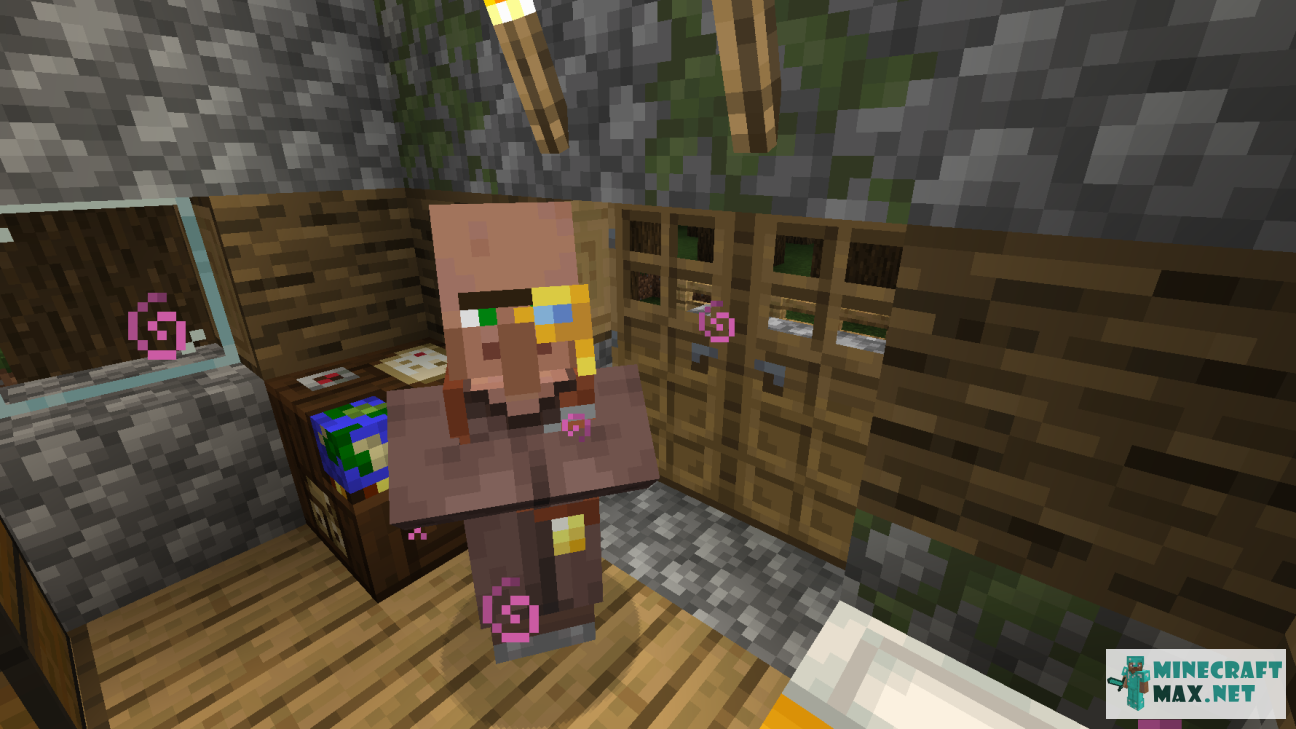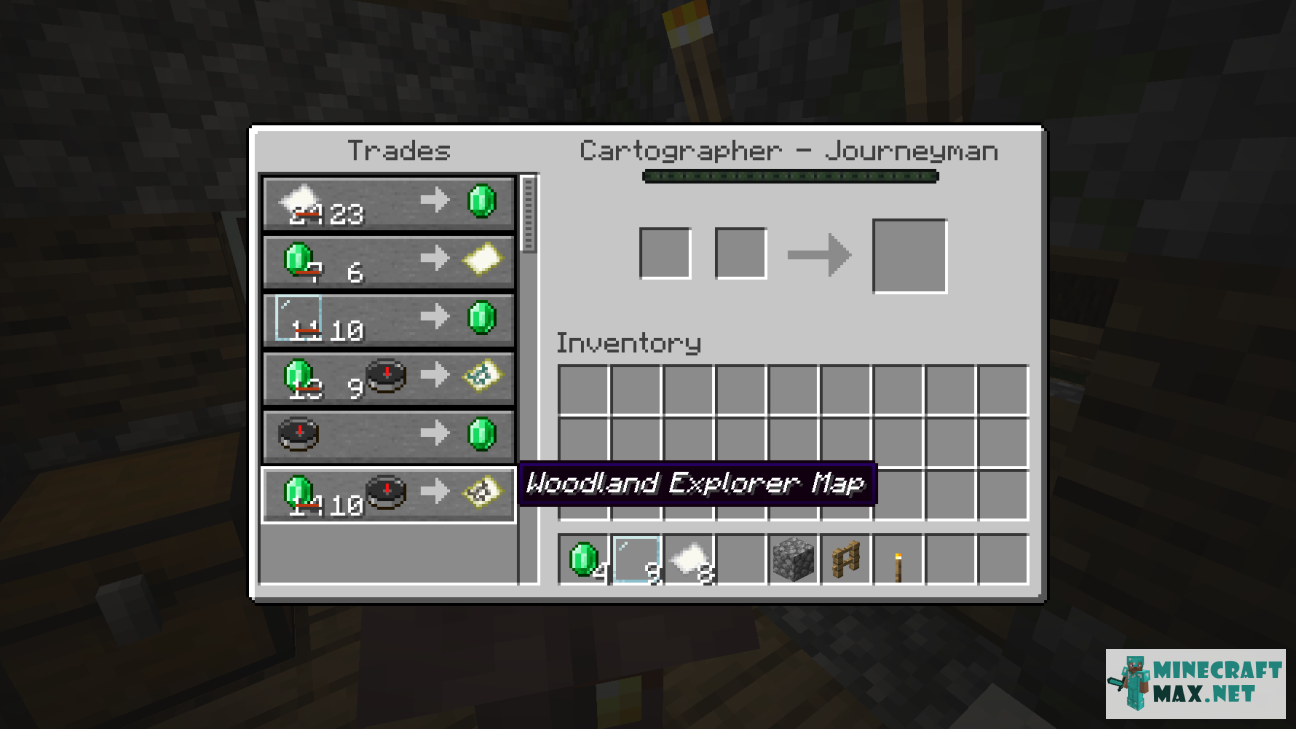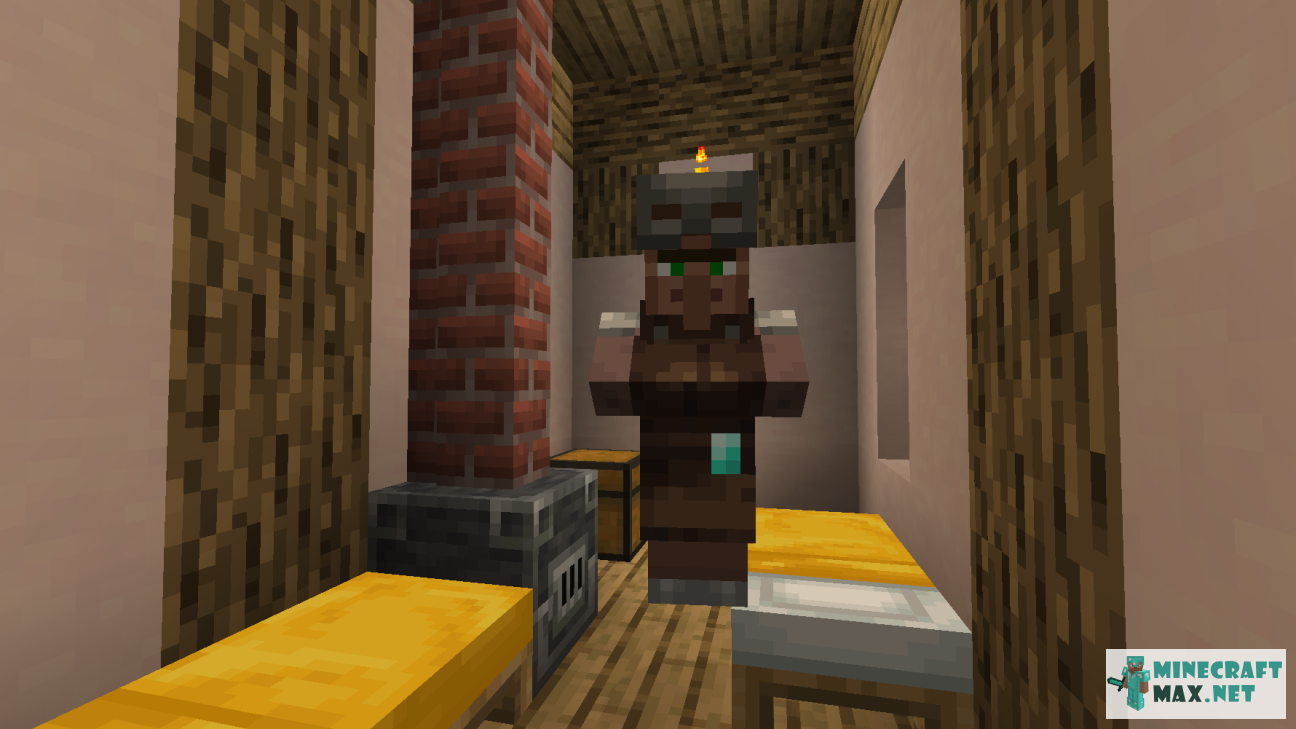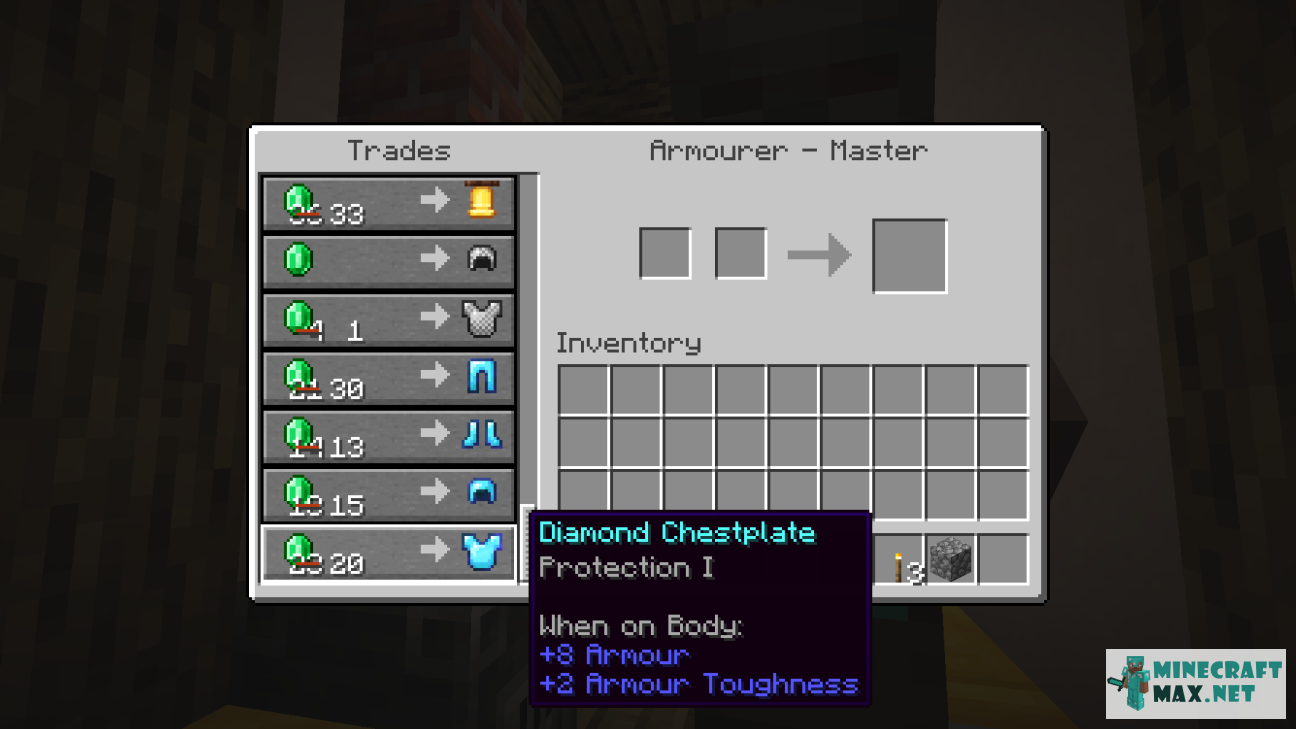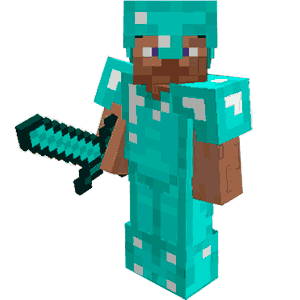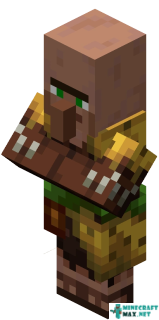
Trading is one of the mechanics of the game that allows the player to make deals with villagers who have a profession to exchange emeralds for various goods and vice versa. The mechanics of trading may seem complicated for newbies in Minecraft: transactions will not always be profitable for the player, and the price of goods can be considerable. But with the right approach, using trades with villagers, you can get valuable and unique items that will greatly simplify the gameplay.
- Synonyms: Торговля с крестьянином / Как торговать с жителем
- Minecraft versions: 11 / 10.5.1 / 1.22 / 1.21 / 1.20 / 1.19.1 / 1.19
Modify date: 11/06/2022
Questions about trades with villagers
Here you will find detailed answers to frequently asked questions about trades with villagers.
In order to start trading with the villager, you need to find a village and have a supply of emeralds. If there are usually no problems with finding a village, then it's not easy to find emeralds in Minecraft.
The main ways to get emeralds in the game:
- During the development of mines and in the thickness of rock in mountain biomes (but emeralds are less common than diamonds, and in the amount of 1 block, very rarely 2 blocks).
- 1-3 emeralds can be found in the chests of sunken ships and treasuries.
- Trade with peasants: Each representative of the profession has at least one transaction that will bring the player one emerald after its completion.
First of all, need to make sure that there are villager in the village with whom trading is possible. These are villager who have a profession and a work unit corresponding to this profession. You cannot trade with an unemployed villager, a nitwit and a child. Villager with a profession can be distinguished fr om an ordinary peasant by special clothing, which is different for each profession. A villager of a certain profession has his own range of goods and trade for the player.
In order to start trading with a villager, you need to right-click on it. This action will open the trading interface, wh ere on the left there will be all the transactions available to the player, at the very top the level of development of the profession of this villager with the scale of experience, and just below – the cells for the transaction. At the bottom right will be the player's inventory.
- Armorer (melting furnace) – iron and chain mail armor, bell, shield.
- Butcher (smokehouse) – cooked rabbit meat, fried pork and chicken.
- Cartographer (cartographer's table) – treasure maps, frames, blank maps, flags.
- Cleric (brewing stand) – red dust, lapis lazuli, lightstone, Ender's pearl, experience potion.
- Farmer (composter) – bread, pie, apples, cookies, suspicious soup, golden carrot, sparkling slice of watermelon.
- Fisherman (barrel) – different types of fried fish, a bucket of cod, a bonfire, an enchanted fishing rod.
- Fletcher (fletcher's table) – flint, bow, crossbow with and without charms, arrows of harm.
- Leatherworker (cauldron) – leather armor, leather horse armor.
- Librarian (lectern) – enchanted books, bookshelves, lanterns, compasses, tags.
- Toolmaker (smithing table) – various tools, including enchanted ones.
- Shepherd (loom) – carpets, colored wool, flags and paintings.
- Mason (Stonemason) (stonecutter) – various types of polished blocks, bricks and ceramics.
- Weaponsmith (grindstone) – diamond swords and axes of the maximum level with and without charms.
In this case, the player can assign the villager the profession he needs. To do this, it is necessary to create a workplace for a specific profession, as well as provide villager with a sufficient number of beds. A villager who does not have a profession will approach the work unit himself, which is within reach and is not occupied by anyone yet. Thus, the villager will receive a new profession, and his appearance will change in accordance with the new profession.
It should be remembered that a child and a nitwit will not get a profession.
If there are professions in the village that the player does not need at the moment, then you can replace them with more useful ones for the player. To do this, you need to find a villager with whom the player has never traded, destroy his work block, and install a new block of the desired profession. The villager will start looking for a free working block, and will find the one that the player has set for him. The profession of the villager will be replaced.
Attention: it is better to create a new work block to replace the profession, since if it turns out that the work block is already occupied, then the villager will not be able to use it to change the profession.
If a player has opened the trading interface of a villager with the "Beginner" level and has not found the right trades, then you need to break the working block of this villager and install a new one of the same. With a high degree of probability, the villager will update the trading offers.
Each completed trade transaction adds experience points to both the player and the villager. The scale of the villager's experience will gradually fill up, which will increase the level of proficiency in the profession. In total, villager have five levels of professional development. For each level, the color of the buckle on the belt of the villager changes:
- «Novice» level is available immediately, the buckle is gray (stone).
- «Apprentice» level – 10 experience points, brown buckle (leather).
- «Journeyman» level – 70 experience points, yellow buckle (gold).
- «Expert» level – 150 experience points, green buckle (emerald).
- «Master» level – 250 experience points, blue buckle (diamond).
Each level increases the number of trade transactions of the villager and changes the price of the goods of the villager.
Each product has a certain limit on the number of transactions (on average 12-16). If there is no more product, then in the line with this transaction, the exchange arrow will be crossed out with two red lines. In order for the limit to be restored, a villager needs access to his work unit. Villager update deals several times per game day. If a villager's workplace is destroyed or the villager does not have access to it, he will not be able to restore the finished goods.
With each level increase, the number of deals that a villager can offer to a player increases. With the new level, two random trades are added to the trading interface. The maximum one-time number of transactions for each profession is 10.
The mechanics of trade in Minecraft provides for both the appearance of discounts on goods and an increase in prices for them. It depends on the following factors:
- The reputation of the player in the village is expressed in points and by default is 0. The attitude of the villager to the player and the prices of goods change depending on the reputation points received. Reputation points are added for useful actions, while negative ones are taken away. The higher reputation of the player, the greater the discount will be offered by the villager.
- If a player completely exhausts the limit of a certain transaction, there is a high probability that the price will increase after its resumption. It is logical that if there is a demand for a product, you can expect it to rise in price.
- The status of "Hero of the village", obtained after defeating the raid, gives the player a significant reduction in all prices.
- "Novice": Wheat (20) or potatoes (26) or carrots (22) or beets (15) = Emerald (1).
- "Novice": Raw chicken (14) = Emerald (1).
- "Journeyman": Coal (15) = Emerald (1).
- "Apprentice": Raw Beef (10) = Emerald (1).
- "Novice": Thread (20) or Coal (10) = Emerald (1).
- "Master": Boat (1) = Emerald (1).
- "Novice": Clay Ball (10) = Emerald (1).
- "Apprentice": Stone (20) = Emerald (1).
- "Journeyman": Granite or Andesite or Diorite (16) = Emerald (1).
- "Novice": Coal (15) = Emerald (1).
- "Apprentice": Iron Ingot (4) = Emerald (1).
- "Novice": Coal (15) = Emerald (1).
- "Apprentice": Iron Ingot (4) = Emerald (1).
- "Novice": Stick (32) = Emerald (1).
- "Apprentice": Thread (14) = Emerald (1).
- "Novice": Rotten Flesh (32) = Emerald (1).
- "Novice": Coal (15) = Emerald (1).
- "Apprentice": Iron Ingot (4) = Emerald (1).
- "Journeyman": Bucket of Lava (1) = Emerald (1).
- "Apprentice": Glass (11) = Emerald (1).
- The player can quickly find a villager who is ready to make a deal with a certain item if he holds it in his hands. In turn, the villager will show the goods that he is ready to exchange for this item.
- After the player has traded with a villager, the merchant cannot become unemployed, even if the block of his workstation is broken. The villager will continue to develop the levels of the profession with each new transaction. But it will not be able to restore the limit of goods that have run out.
- The player's death will not reset the reputation level. As soon as the reputation reaches -15, the golem will begin to regard the player as an enemy and will attack him. In each individual village, the player has a separate reputation level.
- You can create a Trading farm of villager to provide yourself with a constant source of not only emeralds, but also many other useful items.
- One of the ways to farm emeralds:
To make each villager a cartographer, to terminate to the second level
Make several stoves, fill them with coal
Get a lot of sand and melt it into glass, and make panels out of glass
Since the cartographers on the second level buy glass panels, such a scheme can bring up to several stacks of emeralds per day.
 How to craft trades with villagers
How to craft trades with villagers
Unfortunately, there is no recipe how to craft trades with villagers in Minecraft. But you can see where you can find trades with villagers in Minecraft.
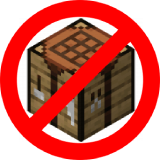
Can't be crafted
Unfortunately, trades with villagers cannot be crafted in the inventory or on the workbench in Minecraft.
 Screenshots of trades with villagers
Screenshots of trades with villagers
There are 4 screenshots on the site, which has trades with villagers in Minecraft. Below you can see these screenshots to get a better idea of what trades with villagers looks like in Minecraft.
